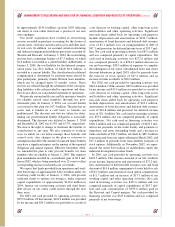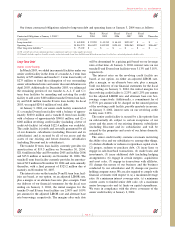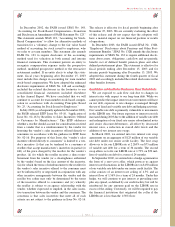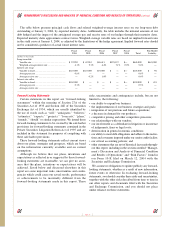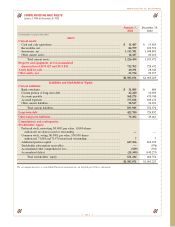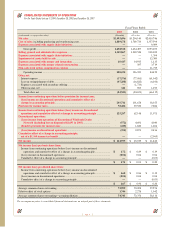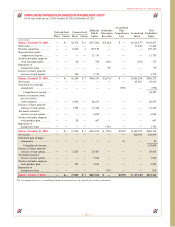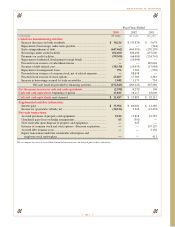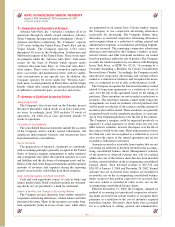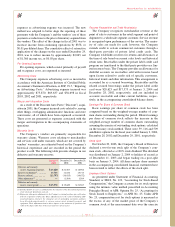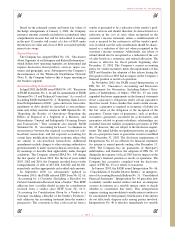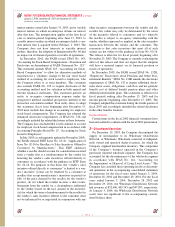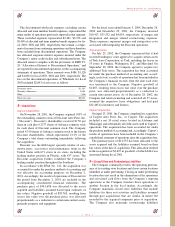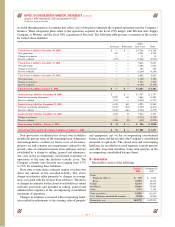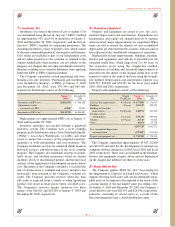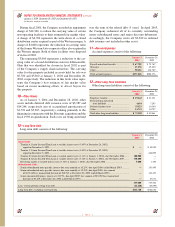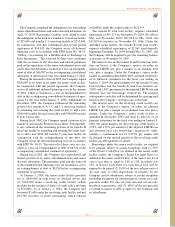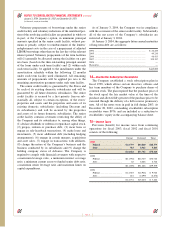Advance Auto Parts 2003 Annual Report Download - page 30
Download and view the complete annual report
Please find page 30 of the 2003 Advance Auto Parts annual report below. You can navigate through the pages in the report by either clicking on the pages listed below, or by using the keyword search tool below to find specific information within the annual report.
1—Organization and Description of Business
Advance Auto Parts, Inc. (“Advance”) conducts all of its
operations through its wholly owned subsidiary, Advance
Stores Company, Incorporated and its subsidiaries (“Stores”).
Advance and Stores (collectively, the “Company”) operate
2,539 stores within the United States, Puerto Rico and the
Virgin Islands. The Company operates 2,503 stores
throughout 39 states in the Northeastern, Southeastern and
Midwestern regions of the United States. These stores oper-
ate primarily under the “Advance Auto Parts” trade name
except for the State of Florida which operate under
“Advance Discount Auto Parts” or “Discount Auto Parts”
trade names. These stores offer automotive replacement
parts, accessories and maintenance items, with no signifi-
cant concentration in any specific area. In addition, the
Company operates 36 stores under the “Western Auto”
trade name, located primarily in Puerto Rico and the Virgin
Islands, which offer certain home and garden merchandise
in addition to automotive parts, accessories and service.
2—Summary of Significant Accounting Policies
Accounting Period
The Company’s fiscal year ends on the Saturday nearest
the end of December, which results in an extra week every
six years. Accordingly, fiscal 2003 includes 53 weeks of
operations. All other fiscal years presented include 52
weeks of operations.
Principles of Consolidation
The consolidated financial statements include the accounts
of the Company and its wholly owned subsidiaries. All
significant intercompany balances and transactions have
been eliminated in consolidation.
Use of Estimates
The preparation of financial statements in conformity
with accounting principles generally accepted in the United
States of America requires management to make estimates
and assumptions that affect the reported amounts of assets
and liabilities and the disclosure of contingent assets and lia-
bilities at the date of the financial statements and the reported
amounts of revenues and expenses during the reporting
period. Actual results could differ from those estimates.
Cash, Cash Equivalents and Bank Overdrafts
Cash and cash equivalents consist of cash in banks and
money market funds. Bank overdrafts include net outstand-
ing checks not yet presented to a bank for settlement.
Vendor Incentives and Change in Accounting Method
The Company receives incentives from vendors related to
cooperative advertising allowances, volume rebates and other
functional discounts. Many of the incentives are under long-
term agreements (terms in excess of one year), while others
are negotiated on an annual basis. Certain vendors require
the Company to use cooperative advertising allowances
exclusively for advertising. The Company defines these
allowances as restricted cooperative advertising allowances
and recognizes them as a reduction to selling, general and
administrative expenses as incremental advertising expendi-
tures are incurred. The remaining cooperative advertising
allowances not restricted by the Company’s vendors, or unre-
stricted, rebates and other functional incentives are earned
based on purchases and/or the sale of product. The Company
accounts for vendor incentives in accordance with Emerging
Issues Task Force, or EITF, No. 02-16, “Accounting by a
Customer (Including a Reseller) for Certain Consideration
Received from a Vendor.” Accordingly, the Company records
unrestricted cooperative advertising and volume rebates
earned as a reduction of inventory and recognizes the incen-
tives as a reduction to cost of sales as the inventory is sold.
The Company recognizes the functional incentives earned
related to long-term agreements as a reduction of cost of
sales over the life of the agreement based on the timing of
purchases. These incentives are not recorded as reductions to
inventory. The functional amounts earned under long-term
arrangements are based on estimates of total purchases that
will be made over the life of the contracts and the amount of
incentives that will be earned. These incentives are generally
recognized based on the cumulative purchases as a percent-
age of total estimated purchases over the life of the contract.
The Company’s margins could be impacted positively or
negatively if actual purchases or results from any one year
differ from its estimates, however the impact over the life of
the contract would be the same. Short-term incentives (terms
less than one year) are recognized as a reduction to cost of
sales over the course of the annual agreement and are not
recorded as reductions to inventory.
Amounts received or receivable from vendors that are not
yet earned are reflected as deferred revenue in the accompa-
nying consolidated balance sheets. Management’s estimate
of the portion of deferred revenue that will be realized
within one year of the balance sheet date has been included
in other current liabilities in the accompanying consolidated
balance sheets. Total deferred revenue is $19,524 and
$20,592 at January 3, 2004 and December 28, 2002. Earned
amounts that are receivable from vendors are included in
receivables, net on the accompanying consolidated balance
sheets except for that portion expected to be received after
one-year, which is included in other assets, net on the
accompanying consolidated balance sheets.
Effective December 31, 2000, the Company changed its
method of accounting for unrestricted cooperative advertis-
ing funds received from certain vendors to recognize these
payments as a reduction to the cost of inventory acquired
from these vendors. Previously, these funds were accounted
for as a reduction to selling, general and administrative
NOTES TO CONSOLIDATED FINANCIAL STATEMENTS
January 3, 2004, December 28, 2002 and December 29, 2001
(in thousands, except per share data)
Page 28


